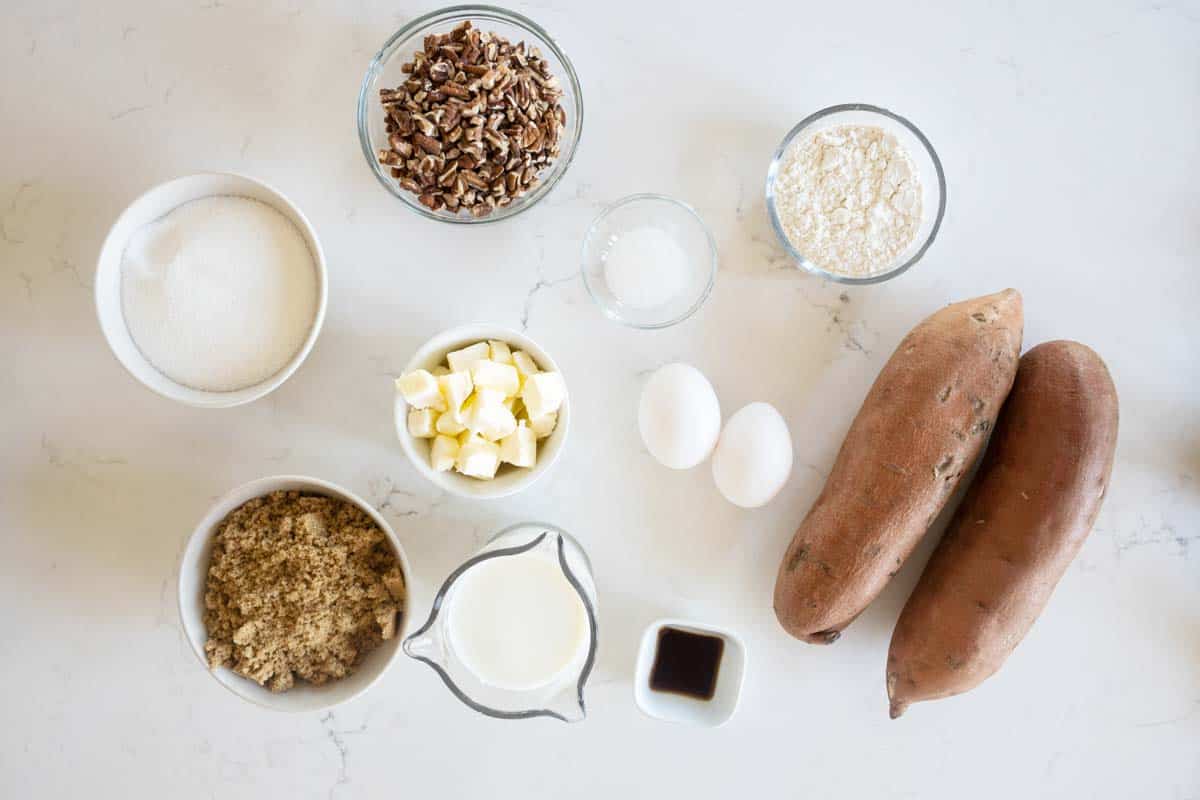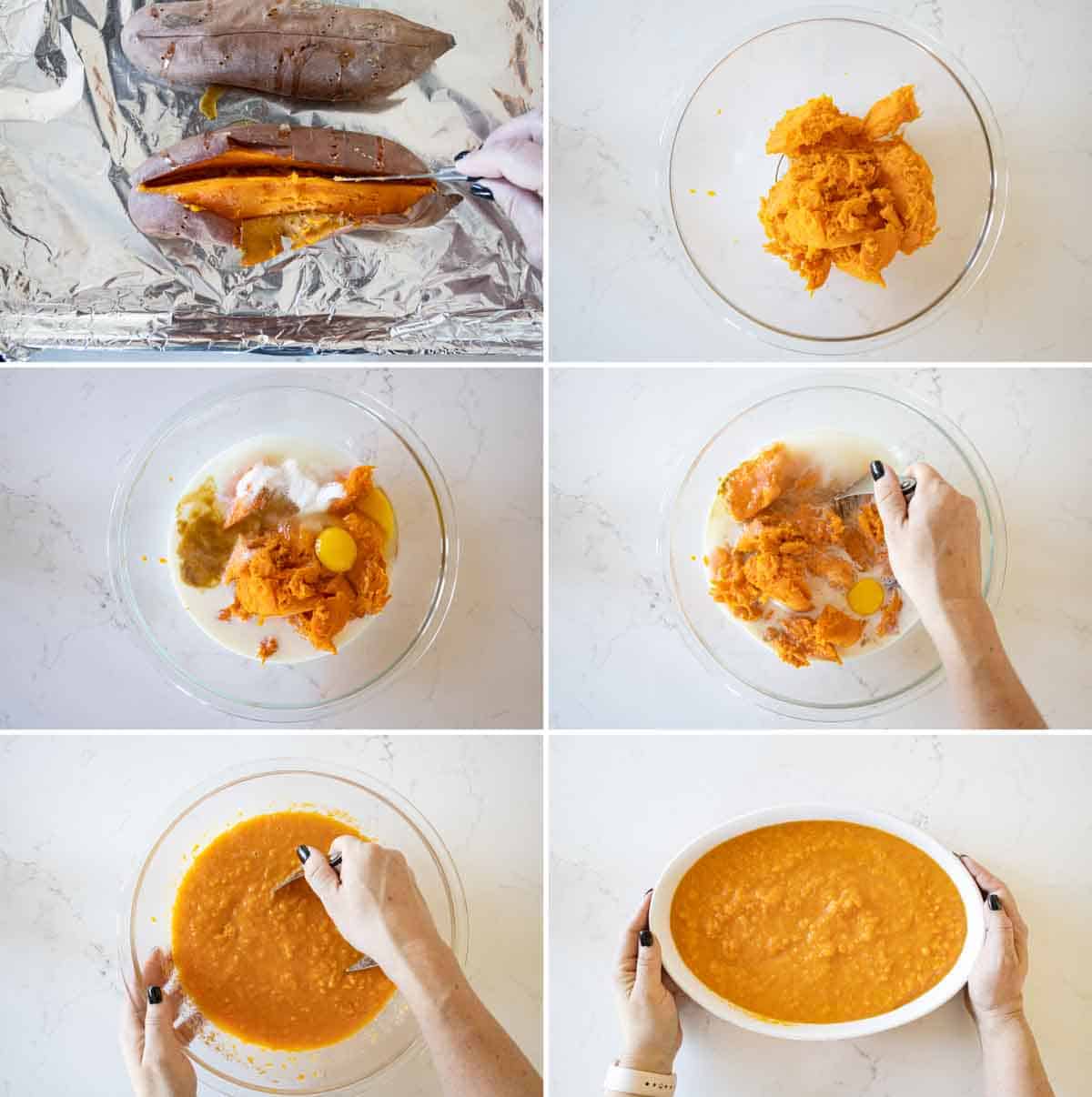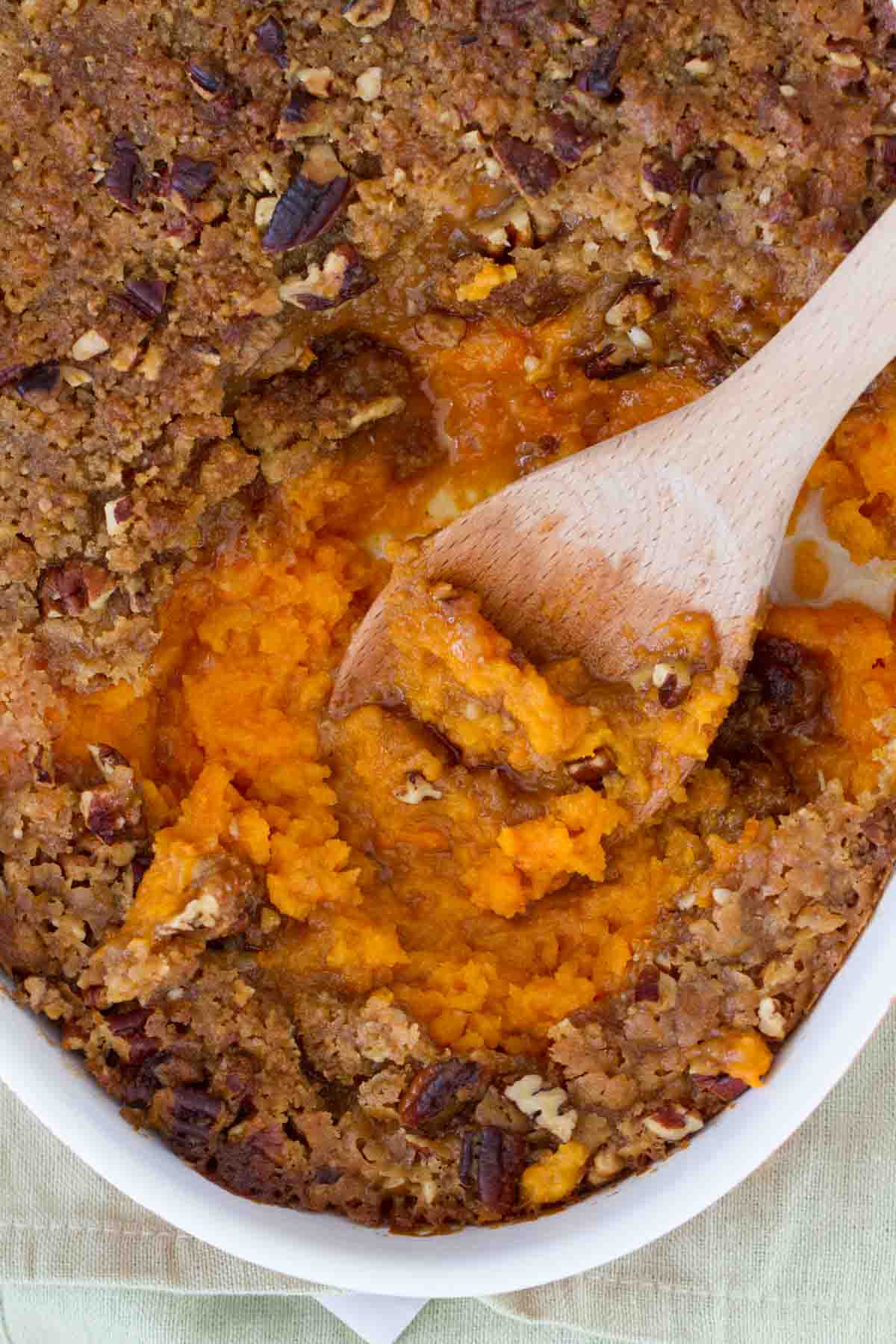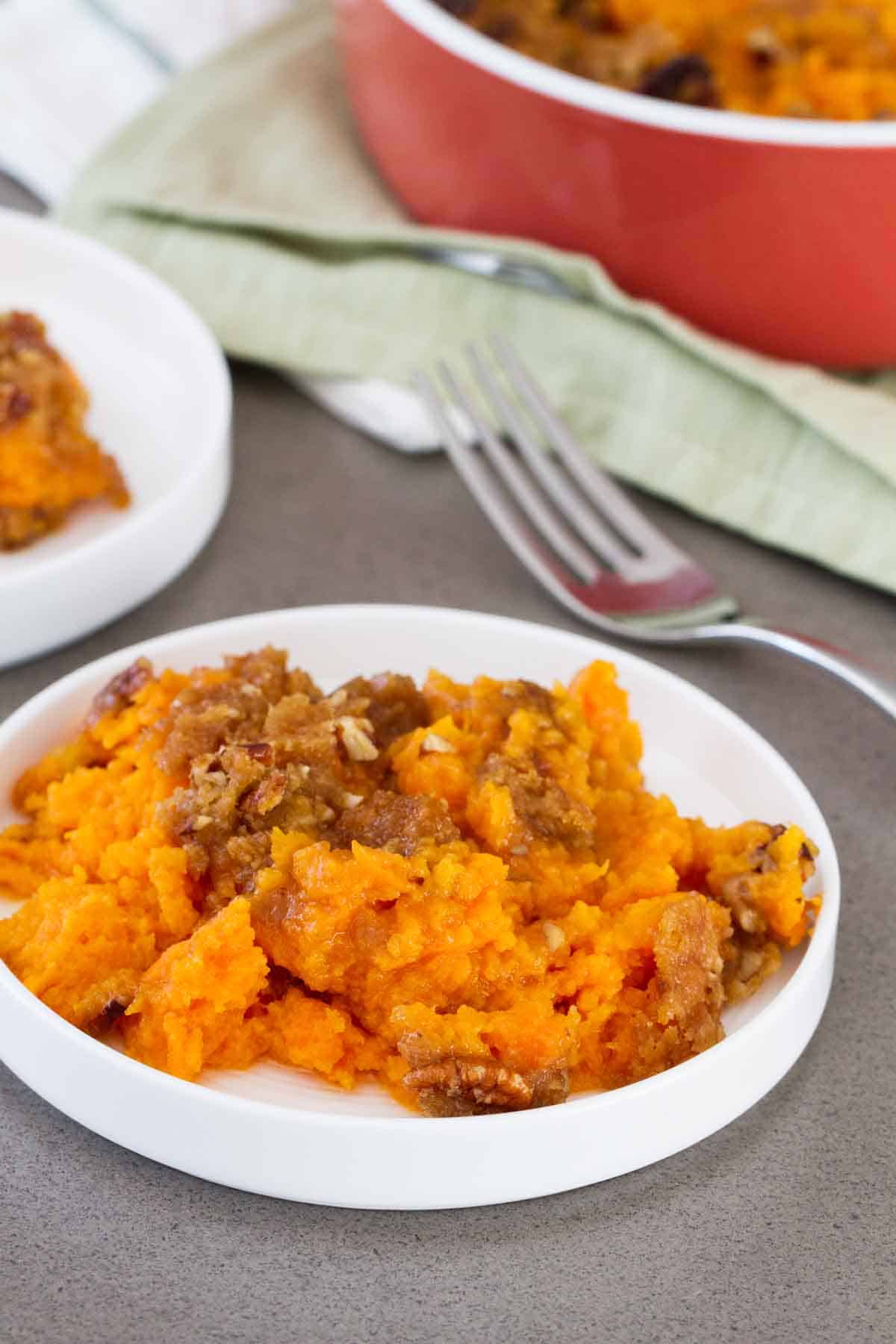Sweet potato casserole, a beloved Thanksgiving staple, can sometimes turn out watery, leaving you with a dish that lacks the desired consistency. Fear not! With a few simple techniques, you can transform your watery sweet potato casserole into a thick, creamy delight that will impress your family and guests.
Causes of Watery Sweet Potato Casserole
Before delving into the solutions, it’s essential to understand the potential causes of a watery sweet potato casserole:
-
Excess moisture in sweet potatoes: Sweet potatoes naturally contain a fair amount of moisture. If they are not properly drained or mashed, this excess moisture can lead to a watery casserole.
-
Insufficient thickening agents: Thickening agents, such as flour, cornstarch, or eggs, help bind the ingredients together and create a cohesive texture. If your casserole lacks these agents, it may turn out runny.
-
Overcooking: Overcooking sweet potatoes can break down their cell structure, releasing more moisture and resulting in a watery casserole.
Solutions to Thicken Sweet Potato Casserole
Now that you know the potential causes, let’s explore the solutions to thicken your sweet potato casserole:
-
Drain the sweet potatoes thoroughly: After boiling or baking the sweet potatoes, drain them well in a colander. Use a paper towel or cheesecloth to gently press out any remaining excess moisture.
-
Mash the sweet potatoes until smooth: Use a potato masher or ricer to mash the sweet potatoes until they are smooth and free of lumps. This will help remove any excess moisture and create a more cohesive texture.
-
Add thickening agents: Incorporate thickening agents such as flour, cornstarch, or eggs into your casserole. Flour and cornstarch can be mixed with a small amount of cold water to form a slurry before adding it to the casserole. Eggs add richness and help bind the ingredients together.
-
Simmer the casserole: Simmer the casserole over low heat, stirring occasionally, until it thickens to your desired consistency. This allows the thickening agents to fully hydrate and work their magic.
-
Use a food processor: If you prefer a smoother texture, you can use a food processor to puree the sweet potatoes until they reach a thick, creamy consistency.
Additional Tips
-
Don’t overmix the casserole: Overmixing can break down the sweet potatoes further, releasing more moisture and making the casserole runny. Mix just until the ingredients are combined.
-
Bake the casserole uncovered: Baking the casserole uncovered allows excess moisture to evaporate, resulting in a thicker casserole.
-
Let the casserole rest: After baking, let the casserole rest for a few minutes before serving. This allows it to set and thicken further.
With these simple techniques, you can transform your watery sweet potato casserole into a thick, creamy delight that will be the star of your Thanksgiving feast. Remember to drain the sweet potatoes thoroughly, mash them until smooth, add thickening agents, simmer the casserole, and avoid overmixing. By following these steps, you’ll create a sweet potato casserole that is both delicious and visually appealing.
The Best Sweet Potato Casserole Recipe
I love trying new recipes. However, I will admit that there are some recipes that I must have on my table for the holidays in order for them to feel like holidays. This sweet potato casserole recipe, along with pumpkin pie and cranberry salad, is perfect for Thanksgiving. Since I made this recipe for sweet potatoes for the first time back in 2007, I believe I have only missed one Thanksgiving. And I have vowed to never let that happen again.
I love, love, love sweet potatoes. I love a good dish of Mashed Sweet Potatoes. Don’t get me wrong though—I wouldn’t even turn down sweet potatoes with marshmallows on top.
But really, nothing tops this sweet potato casserole!

- Sweet potatoes: Two pounds of sweet potatoes, or four small to medium-sized or two large ones, will be needed. Mine in the photo were quite large.
- Sugar: Regular granulated sugar is what goes in the filling.
- Milk: I use 2 percent, but a whole or even 1 percent should be okay. One of my commenters even mentioned using evaporated milk, which is a fantastic substitute.
- Eggs: I use large eggs. The eggs are what hold everything together, so don’t skip them!
- Vanilla: I like to use real vanilla extract.
- Salt: To balance the flavors.
- Brown Sugar: The brown sugar is for the topping. You’ll be making a streusel-type topping.
- Flour: All-purpose works best here.
- Although I prefer unsalted butter for this recipe, you can use salted instead. Make sure the butter is chilled before chopping it into tiny cubes.
- Pecans: For more flavor, toast your pecans before chopping them.

How to Make the Brown Sugar Topping
- Mix the butter, flour, and brown sugar in a different bowl.
- To make the mixture resemble coarse crumbs, cut the butter into it with a fork or pastry cutter.
- Stir the pecans into the mixture.
- Spread a thin layer of the brown sugar topping over the potatoes.
All you have to do now is bake the sweet potato casserole for 30 to 40 minutes, or until it turns golden brown.

Sure, but if you’re preparing it ahead of time, add the crumble topping right before baking, keeping it separate. Simply put the casserole and topping in the refrigerator until you’re ready to bake them. To bring the sweet potato casserole back to room temperature before baking, I would also let it sit out for a little while. Then add the topping and bake as you normally would. If baking straight out of the refrigerator, allow additional time to bake.
Yes, it is a lot of sugar. Yes, the casserole is sweet. But it really is so good just how it is. Should you be concerned about it being overly sweet, some commenters have reduced the amount of sugar and still found it to be delicious!
Although I haven’t tried it myself, others have successfully substituted 1:1.

- I enjoy the crunch that the pecans add, but feel free to omit them if you’re allergic to them or don’t like them.
- In the United States, sweet potatoes are frequently labeled as yams. Should they be white or orange? However, 99% of the time, they’ll just be delicious potatoes. It’s actually rather uncommon to find yams in your grocery store. Therefore, using either what is labeled as sweet potatoes or yams would be fairly safe. Both orange and white will work in this instance as far as color goes, but I think the orange is preferable because it looks better and is a little sweeter.
- Although roasting potatoes is my preference, you can boil them or cook them in a slow cooker if that’s more convenient for you.
- Sometimes the filling appears runny before baking, but it will firm up a little bit in the oven. This is a recipe I have made numerous times, and each time it is unique. Because potatoes vary in their water content, some of them will always be runnier than others. But it will set up once cooked.
- Store leftovers covered in the refrigerator for 3-5 days.
How To Make Sweet Potato Casserole BETTER Than Ruth’s Chris (Special Guest Taste Tester!)
FAQ
How do you fix a watery sweet potato casserole?
Why is my potato casserole runny?
How do you fix a soupy casserole?
How do you know when sweet potato casserole is set?
Can you mess up a sweet potato casserole?
With its sweet filling and (sometimes) savory topping, sweet potato casserole is the ultimate crowd-pleaser. It’s not fancy or complicated to pull together, but that doesn’t mean there’s no room for error! Here are four ways you can mess up your sweet potato casserole—and four ways to fix it when things go wrong.
How do you cook sweet potatoes?
The best way to cook sweet potatoes is: first preheat the oven. Then, on a baking sheet lined with aluminum foil, prick sweet potatoes all over with a fork. Rub the outsides with a small amount of olive oil if you intend to eat the skins. Bake until tender, 45 to 50 minutes. Let cool, then split the tops open with a knife and top with a pat of olive oil. Season with salt and pepper before serving.
Can You bake a sweet potato casserole if it’s undercooked?
So, say you do have some undercooked bits of sweet potato. You have two choices: Pick them out or bake your sweet potato casserole long enough to soften the underdone pieces. Sweet potato casserole walks a fine line between being savory and sweet. That’s why we love it!
How do you make a sweet potato casserole?
Here’s a quick rundown on how to whip up this tasty sweet potato casserole. 1. Preheat the oven to 325 degrees Fahrenheit and lightly grease a 9×13-inch casserole dish with cooking spray or butter. 2. Bake and mash the sweet potatoes. Pierce the outside skin of the sweet potato with a fork and bake in the oven for one hour.
